
 |
 |
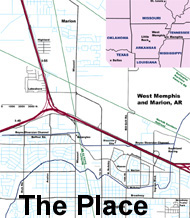 |
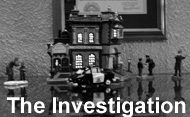 |
 |
 |
 |
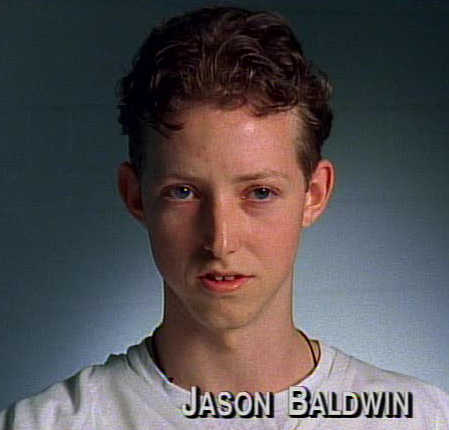 The Case For Innocence, Jason Baldwin Jason Baldwin and Damien Echols were tried together in spite of repeated efforts by Baldwin's attorneys to separate the trials. His attorneys were concerned that the cult evidence and the flamboyant and troubled character of Damien Echols would reflect badly on the quiet and shy Jason. The piece of evidence that put Baldwin in jail in the first place could not be used against him. The constitutional right to face one's accuser is fundamental. Since Misskelley refused to attest to his confessions, his testimony could not be used at trial. It was forbidden to mention the existence of the confessions or their content although Detective Bryn Ridge referenced them during the trial and the jurors took them into consideration during their deliberations. The trial proceeded with little evidence directed towards Baldwin. Although Damien Echols had artifacts of cult material and books, Baldwin had none of these. Baldwin's probation officer, Steve Jones, has recently spoken on record that he "cannot, in retrospect, accurately attribute to Petitioner Baldwin any professed interest in or assocation with the occult or satanism. [Jones] now acknowledges that he does not believe that Baldwin was involved in the homicides." [p. 167, Jessie Misskelley, Habeas Petition.] No eyewitnesses placed Baldwin near the crime scene, he had no history of violence or drug use. The key piece of evidence was a jailhouse snitch, Michael Carson, who appeared shortly before the trial to say he overheard Baldwin confess. One fiber was linked to Baldwin's mother's robe. The evidence was so sparse that Baldwin's attorney, Paul Ford, made a bold move. He only called one witness who would testify as to the questionable finding of similarity of the fiber. Baldwin's defense rested. In his closing argument, Ford noted the lack of evidence. Ford:
The only evidence they've got is Michael Carson. Boil it down,
that’s what they got. This sixteen-year-old career criminal with
a soft heart. That’s what they got. Where was their evidence
before February the first? Jason was arrested June the third. Where was
their evidence? [Echols/Baldwin trial]
Prosecutor Brent Davis agreed that finding Baldwin guilty would be a hard decision, citing only the fiber and the snitch in his closing argument. Davis:
In regard to Jason, the red fiber, and what Michael Carson said. Cause
this is the time when you gotta make hard decisions. Michael Carson,
he's either - he's lying to you or he's telling you the truth. And it's
not somewhere in between. And I put to you he's telling you the truth.
Kids like him don't come in here do that for nothing. [ibid]
What convicted Jason Baldwin? The jurors took notes during deliberations. The witnesses were ranked in terms of significance and pros and cons were written for each. Summary lists of the pros and cons were composed for the defendants. The list for Jason Baldwin is presented below.
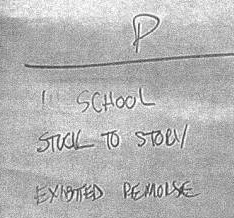 Pros, jury chart, Jason Baldwin The Pros. In school. The fact that Jason Baldwin was in school on the fifth of May came out during a cross-examination of Detective Bryn Ridge. This is vaguely supportive of innocence, speaking at least some to character. Baldwin's attorney could have done much more if he had presented a defense. According to his attendance records, Jason Baldwin had not missed a day of school for the three months prior to the murders. He did not miss school the morning after the murders. He continued attending classes until he was arrested. One of his teacher's volunteered to testify in his favor as a character witness. Stuck to story. It is not certain what the jurors meant. If they meant he did not confess and retract, this conflicts with the claim he did confess to a jailhouse snitch. Here his consistency is listed as a positive. Not testifying, Baldwin had no story to stick to. Exibited remorse. Again this is confusing. Although this could certainly be used for determining punishment, why would this be listed as a positive used to determine guilt or innocence? How did he exhibit remorse? Pleading not guilty is denying responsibility, not being remorseful for it. 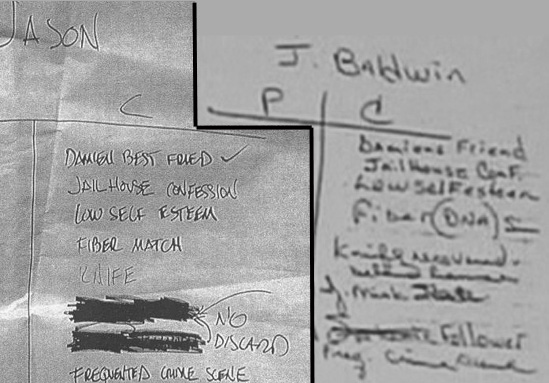 Jason Baldwin, juror notes, cons, composite. Left side is the jury as a whole. Right side is a list of juror #7. The Cons. Damien Best Fried (sic). Baldwin's attorneys' fears were realized. The primary item on the list of evidence of guilt was Baldwin's friendship with Damien Echols, accented by a checkmark. The guilt by association was a powerful influence. That’s
what they want right there. Guilt by association. Because he’s
sitting over there with Damien, they want you to convict him. 'Cause he has a best friend or a good friend, they want you to
convict him. [Paul Ford, closing arguments, Echols/Baldwin trial]
Jailhouse confession. The key piece of evidence against Jason Baldwin was the 16 year old jailhouse snitch, Michael Carson. At that time Carson first appeared to make his allegations, Baldwin had been in prison for eight months. One month later, he would be at trial. I will discuss his statements and testimony at length. 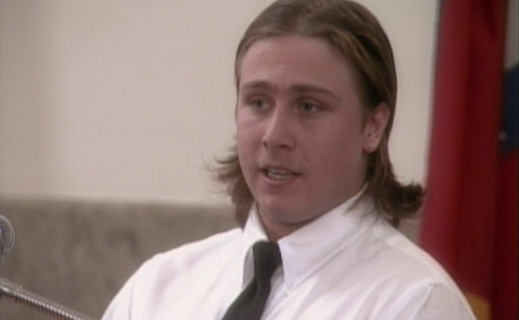 Michael Carson, testifying. By the time of the trials, Michael Carson had been in and out of juvenile facilities for burglary and falsifying his identity. He had completed at least two stays in mental health facilities. He was diagnosed as having alcohol, hallucinogen and marijuana dependency and polysubstance abuse. His counsellor contacted Baldwin's defense attorneys to warn them of his concerns that Carson would lie about his testimony. The counsellor was interviewed by the prosecution. Williams: I told him [Baldwin's attorney] that I had meet with Michael sometime in December and I felted very uneasy and very bad that I had discussion some rumors or facts about this case and some things I had heard, about um satanic related killings and that, what Michael had told me uh, strongly indicated to me that he had basically repeated what I had told him to the police and I felted pretty guilty that testimony was going to be used. [snip] . . .we got to talking about the West Memphis case, and I told Michael either that, I don't remember if I told him that this allegedly happened in this case or in a lot of satanic related killings that um, the scrotum or testicles are cut the victim, that blood is used in the significance, um that sometime they use the scrotum to drink blood from their victims and I don't remember, I think I remember something about um, the victims might have been allegedly their skin removed. . . [Counsellor Danny Williams interview with Brent Davis, February 18, 1994]The counsellor was not permitted to testify. It was ruled his testimony would violate the therapist/client privilege of a minor. Carson's history of drug use was also excluded as evidence. Piecing together Michael Carson's timeline is difficult because of conflicts between his statements and testimony. The general outline is this:
Davis:
Objection, your Honor. He is cross-examining on a report generated by
Officer Beall, Officer Beall took. And he has a transcript of the
recorded statement given by Michael and he also has a paraphrased
report and that report is not proper cross examination for this
witness. He can cross-examine him based on the statement, the
transcript of the statement. [Echols/Baldwin trial]
Discrepancies in the content of Carson's statements and testimony. Key:
January = January 20, 1994 interview notes. February = February
1, 1994 interview. March trial = Echols/Baldwin trial
testimony. The words in quotation marks are those of
Michael Carson, unless otherwise noted.
His time in jail. January: "I was in jail at the Craighead County Detention Center in early August of September 1993." (sic)
February: August or September. March trial: August. January: "I was there about a week and a half."
February: Length of stay not specified. March trial: How long he was in jail became briefer and more specific with repeated questioning. Davis: How long were you in the detention facility?
Carson: About a week. [snip] Ford: Now, how many days were you in jail? Carson: I believe up to a week. Ford: You believe up to a week? I'm trying to be a little more exact than "I believe up to a week." How many days were you in jail? Carson: At least five. Ford: At least five. What's the most days you were in jail? Carson: Five. The card game. January:
"We were playing cards. Jason LNU, myself, Beddle, and Baldwin. The
other Jason was my partner, and Beddle and Baldwin were partners. We
were playing spades." LNU = police abbreviation for last name unknown.
February: "Well, I was sitting there watching TV and, huh, Jason, and I forget, a couple of black people, they started to play spades, and I was sitting there watching TV and they needed another partner cause nobody else wanted to play and they ask me if I wanted to play and I told them that I didn't know how, so they said they would teach." Detective Beall then reminded him of the other players names from the previous interview. Carson agrees, saying "Beddle or Beetle." To reconcile the January and February statements Jason LNU and Beddle would be the other two black players. March trial: "Another guy named Jason and he had burns all up and down his arm, and there's this guy named Beddle -- I mean it was his nickname -- and a couple of black people in there, Leonard, Xavier and some other little kid. I don't know his name." In this case, Carson is making a distinction between Jason (LNU), Beddle, and the black people there. This indicates that the black people are not Beddle or Jason (LNU). He goes on to describe the makeup of the card game. Carson: I
would usually watch TV but one evening they needed somebody to play
spades with, and I told them I didn't know how to play, and they said
they would teach me.
Davis: Who all was involved in that? Carson: Me and Jason, Beddle and another Jason. The timing of the confession. January:
(continuing during the card game) "I came out and ask Baldwin if
he did it and he said, 'no.' The next day, they had just called
us to go into our cells for lunch. I said, just between me and
you, did you do it? Baldwin's answer was, 'yes, I did it.'" [snip, after conveying the gory details] "Actually it wasn't until two or three
days later Baldwin told me the gory details about the balls and the
penis."
February: "I turned to Jason and said, did you really do it? Straight out just like that in front of Jason and Beddle and he denied it the very first time I ask him." [The next day. . .] "we was sitting there playing spades and then the officer comes over the intercom and tells us to get in our cells, because she's fixing to bring lunch in and so me and Jason was sittin there scraping up some cards and I turned to him and said, 'between me and you, did you really do it'? And he said, 'yes, I did do it,' and he started giving me the gory details." March trial: The timeline presented in his testimony is summarized as follows. For the first two days, he was in lockdown. The next evening he had his initial game of spades. Then, the next day just as they were getting ready for lunch, during a short conversation between the two of them, Jason confessed. Excerpts from the trial testimony: Davis: For the first two days you're in lock down, right?
Carson: That's right. [snip] Carson: Yes. The first time I asked him if he did it, he denied it in front of Jason and Beddle. [snip] Carson: I think it was like the next day. I believe it was the next day. [snip] Carson: Me and Jason Baldwin were scraping up the cards to go into our cells for lunch because they make us go into our cells for lunch. We was scraping up the cards. I said, just between me and you, did you do it. I won't say a word. He said yes and he went into detail about it. The January statement "actually it was two or three days later Baldwin told me the gory details" implies that there was more than one confession, first saying yes he did it and then later giving the details - a major change in story. Carson reconciled this discrepancy during the trial suggesting he was including his own lockdown time in counting the time before the confession. Ford: Did you tell Charlie Beall that it was two or three days later when he gave you the details? Did you tell him that?
Carson: Yes, sir, cause it was two or three days later before I got to talk to him from after I first showed up in jail. [Echols/Baldwin trial] It is impossible to reconcile the various timelines Carson gave. According to his court testimony, he was in lockdown for two days. The third day would have been the initial encounter with Baldwin in which he didn't confess. The fourth day would have been the day he confessed. This conflicts with two to three days after entering. Three days after the initial confession to have provided the gory details would have been the sixth day - and he testified he was there for five. In summary, in various accountings Baldwin confessed on the second, third, fourth, fifth and/or sixth day of Carson's five day stay. There are also these internal oddities. "I would usually watch TV but one evening they needed somebody to play spades with. . ." This was his first night out of lockdown. There were no prior evenings to establish a usual behavior. He also describes his first time playing cards, "Well, we was all sitting there, there was teaching me how. I was gettin confused and stuff so we was all laughing last night." Again, this is suggesting last night was a time outside of lockdown. Length of time of conversation. January: "We had about two minutes to talk."
February: No statement as to length of conversation. March trial: "Two to three minutes." (later) "Pretty close to five minutes." Ford: Ok. And, how long was this conversation?
Carson: I'm not certain. Probably about two or three minutes. [snip] Ford: Tell me, how long did this conversation between you and Jason where he relates all these things to you, how long did that last? Davis: Your Honor, I object. That's been asked and answered. Ford: I don't remember his answer, your Honor. Burnett: It's been asked and answered. So avoid repetition. I'm going to allow him to answer one more time. Ford: Ok I don't remember your Honor. How long did it take? Carson: Pretty close to five minutes. The gory details. The involvement of others. January:
"Baldwin told me that, 'we sucked blood from a penis.'" [snip]
"Baldwin told me that Damien did this along with him."
February: From the transcript. Beall: Okay, did he mention anything about, huh, about the other two, Damien or Misskelly, or anything along that line?
March trial:
This matter became very important in the trial. If Carson
described any claimed actions by Damien, it would be hearsay. The
prosecutors explained to Judge Burnett this would not be a problem.Carson: No, he said, the thing he said really about Misskelly is that he was going to kick his ass when he got out. [snip] Beall: Okay. Did he mention anything about Damien, anything that he might have done? You know, just think hard, and if it comes to you fine, if it doesn't fine. Carson: Not that I can remember. Fogleman: He’s not going to say anything about Damien.
Davis: He’s been instructed -- and I think his statement is something to the effect that he can’t remember whether Jason mentioned Damien or not. The gory details. Multiple mutilations. Since it had been reported incorrectly in the press that the victims (plural) had been sexually mutilated, the fact that this had happened to only one child was considered to be inside knowledge. Carson made several references to sexual mutilation. January:
(repeating and adding to above) "Baldwin told me that, 'we
sucked blood from a penis.'" [snip] "He told me, 'we played with
the balls after they were out of skin.' Baldwin told me he put the
balls in his mouth." [snip] "Baldwin told me he put the
balls in his mouth and sucked the blood out of the penis."
[snip] "Baldwin sounded like they only cut one dick off."
(Note: the penis was skinned, not cut off.)
In summary, in the January statement all of the statements refer to a single penis. The term "balls" could refer to those of a single child. February: (plural form CAPITALIZED to emphasize the contradiction.) Carson:
He was saying like, okay, dismembered THEM, and sucking the blood out
of THEIR scrotums and playing with THERE (sic) balls in his mouth and
stuff like that.
Beall: Okay, did he say how many of the, how many balls, or scrotums, or huh, whatever, penis's that they played with? Michael: No. Beall: Tell me what else he told you. Michael: I, it's been awhile, so all I pretty much remember is scrotum, playing with the penis (note, singular), and putting THEIR, kids balls in his mouth. March trial: For the trial it is plural, again with the caveat of not knowing how many. Davis: You said he went into more detail. What did he tell you?
Carson: He told me how he dismembered the kids, or I don't exactly how many kids. He just said he dismembered them. He sucked the blood from the penis and scrotum and put the balls in his mouth. The gory details. The word "scrotum." January: "He never used the word 'scrotum.'"
February: "He was saying like, okay, dismembered them, and sucking the blood out of their scrotums and playing with there balls in his mouth and stuff like that. [snip] I, it's been awhile, so all I pretty much remember is scrotum, playing with the penis, and putting their, kids balls in his mouth." March trial: "He sucked the blood from the penis and scrotum and put the balls in his mouth." The odd note that Jason Baldwin never used the word "scrotum" conflicts with later recollections. Carson telling his father. January: "The first person I have ever told was my Dad. I was watching TV and he was on the couch. "
February: "We were sittin at home and Dad was watching TV and I was in my room listening to the radio and talking on the telephone and when I walked out there was some news on the West Memphis case. . . And I pointed out Baldwin and I said, 'that's the guy that I was in jail with and then told him.'" [snip] "So like a couple of weeks later, two or three weeks later, he was sitting there, we was watching TV together, and the family of the kids that were murdered came up on there and he said, 'well if you say something that's who you will be helping out, and I ask him who did we need to call.'" March trial: Carson:
My dad was watching something on the case on TV. They showed Jason's
face and I told him that was who I was in there with, and I told him
about it, about the stuff I knew.
Ford: Ok. And two months later, so that would have been September, October, is when you told your daddy. Carson: Yes, sir. The initial encounter is reversed. First he says he was watching TV, then it was his father watching TV. His timeline is problematic. He first told his father in September or October, told him again two or three weeks later, but did not meet with the police until the middle of January. The last minute in which Carson appeared as a witness is perhaps one reason why Baldwin's attorneys were unprepared for his testimony. His motive for coming forward. January:
"I'm not asking anything in return. I don't want anything. I would
refuse anything in return. I'm telling this because it is the truth."
February: Beall: Okay, all right. Has, huh, anyone promised you anything to come forward with this statement about what Jason Baldwin told you?
Carson: No and I would refuse. Beall: Okay. Has, ah, any offered yall any money to come forward with this story? Carson: No. [snip] Huh, yeah, if I was offered any money or anything, I mean I'm not doing this for money, or anything, I'm just doing it to help the family out. March trial:
Davis:
Michael, I forgot to ask you this earlier, were you when you came
forward and told me and then told Officer Beall, gave a statement to
him -- were you offered anything as far as a reward or anything of that
nature?
Carson: No, sir, and if I was I would deny it. [also] Davis: What caused you to come forward at that point in time? Why did Michael Carson no longer want to stay uninvolved? Why did you come forward and testify? Carson: Because I saw the family on TV and saw how broken hearted they were about their children being missing. And I have got a soft heart. I couldn't take it. His statement, "I would deny it," is a bit odd when compared to the other times when he said "I would refuse it," the former sounding as though he would deny the encounter. Aftermath Two years later Michael Carson reappeared in the news. A letter writer identifying himself as the musician, Johnny Preston, claimed Michael Carson had confessed to him that he had perjured himself. Ironically, like Carson's description of Baldwin's confession, Carson's supposed admissions came after only a casual encounter. I
picked up a kid who later told me is Michael Carson. As a homosexual, I
was interested in him as a potential sexual partner. . . [snip] He said he was addicted to dope and had been reduced to burglaries to support his habits. [snip] . . . he wanted to know the maximum penalty for perjury. [snip]
Curious, I sort of pressed him for details, and his reasons for being
concerned about the penalty for perjury. Well, at this point he told me
about being in jail with you [Baldwin] and he had what he called a 'bad
conscience' because he had lied on a boy in court about some kids being
killed around Memphis. [Johnny Preston, letter dated October 28, 1996]
Johnny Preston is a famous singer with a number one hit in the sixties, "Running Bear." The writer of this letter used his name, but the letter also has Preston in prison for 25 years - something that appears to conflict with the life story of the singer. This suggests the letter was not composed by him. On the other hand, the letter was on personalized stationery and for someone to falsely claim to be a famous singer would be a strange risk to take. This letter was eventually presented to the court - I can find no mention that its authorship was determined to be forged. Carson denied the allegation of perjury. In an interview with the press, Carson added more details to Baldwin's confession. Witness Claiming Reports Are False - Michael Carson stands by testimony
While being held at the juvenile detention center at the Craighead County Jail in Jonesboro, Carson said he approached Baldwin and questioned him about the murders. "I had already asked (Baldwin) once if he did it and he said, 'No,' "Carson said, "Then, a couple of days later, I asked him, just between you and me, 'Did you do it?,' Carson said, adding," and he said, 'Yes.'" It was then, Carson said, that Baldwin related how he had used a knife to cut the Byers child in the pubic area and performed a sexual act on the younger boy. [Stan Mitchell, Arkansas Sun, December, 1996] Here we have a couple of days passing. We also have Carson adding in that a knife was used, that Baldwin had identified the Byers boy, and that he had performed a sexual act on the younger boy. Distinguishing who is the youngest among three eight year olds is problematic. Recent developments and the others in jail with Carson and Baldwin. In Baldwin's recent appeal, it is noted the defense investigators tracked down and "interviewed all available staff or detainees who were in the facility with Baldwin and Carson (a total of approximately 10 persons), none could corroborate Carson's story. . . .[The former unit supervisor, Joyce Cureton] has reported that she was actually told by law enforcement personnel to leave town at or near the time that she might have been called as a witness for the defense." [Writ of Error Coram Nobis, Charles Jason Baldwin, filed May 29, 2008] Furthermore, when Cureton was asked to speak on the behalf of Baldwin during sentencing, she "was told by the sheriff that she should not be in court." [Petition for Writ of Habeas Corpus and Motion for New Trial, Jason Baldwin, May 30, 2008, p. 68] Ms. Cureton went into more detail, stating "that when Baldwin was delivered to her facility, the sheriff 'told her that Petitioner should never be let out of his room.' While Cureton did not obey that directive during [Baldwin's] pre-trial incarceration, [Baldwin] was carefully watched when he was outside of his room. . ." [snip] "There were regularly kept records that among other things, allowed staff members to document observations of juveniles." [snip] There was only one log entry of Baldwin and Carson being together and this was under staff observation." [ibid, p.67-68]. One of the correctional officers, Sue Weaver, says she would have noted if a "new person" interacted with Baldwin. [ibid, p.70] The logs for Carson's time in jail have been scrutinized. He arrived on September 1, 1993. There is a note that he had a card game with Jason Baldwin in the evening of September 4. The game was observed by staffmember Ann Tate. [ibid, p.73-74] The other members of the card game were identified as Jason Baldwin, Jason Duncan and Daniel Biddle. These players were interviewed. Although Carson said they played spades, Biddle stated he never played spades while incarcerated. [ibid, p.77] Carson continued to have problems with the law and continued to ply his services as a jailhouse snitch. "Carson moved out of Arkansas, and lived in California where he continued his involvement in criminal behavior according to his record in California. He also allegedly continued to work for local law enforcement agencies as an informant, and reportedly continued fabricating information until he was discarded as an informant after continuing to be arrested." [ibid, p. 84] The recent revelations that the injuries to the penis were the result of animal predation also call into question Carson's claims. 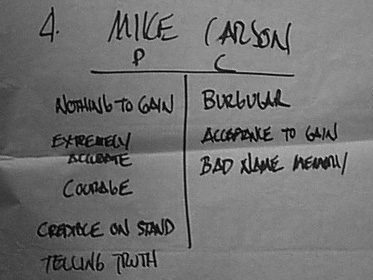 Jury summary notes of the pros and cons of Michael Carson. Continuing down the jury's list for Jason Baldwin. Low self esteem. Another cryptic statement. How did the jury determine Baldwin had low self esteem? Why did they consider this evidence of guilt? Fiber match. The jury's summary note listed, "Fiber Match," while juror number seven wrote "(Fiber) DNA." It is distressing to see, when someone has his life on the line a juror can confuse fiber evidence for DNA evidence. The various and many problems with the fiber evidence are catalogued on a separate page. They include fibers being found similar to multiple sources, different labs coming to different conclusions, source materials being identified as different items, and a haphazard means of collecting items and controls. Officially, fibers can be described as being microscopically similar and consistent from being from the same source, but not as matching one another. Paul Ford attentively challenged a question from Fogleman that suggested they match. Fogleman:
Alright. Back on the red cotton fibers that you had originally reported
matched the garment from Damien Echols' home, which as a result of
further investigation you concluded that it also matched a garment from
the Moore's home. You can't say which home that came from?
Ford: Your Honor, I object to the question because he keeps using the language 'matched.' She's testified that they're not matches, but they're microscopically similar. And I'd ask that he not indicate to the jury that they're matches when that's not her testimony. Burnett: Alright. Ford: I object to the form of the question. Fogleman: I'll rephrase. Burnett: Alright, rephrase your question. [direct examination, Crime Lab Trace Evidence Expert Lisa Sakevicius, Echols/Baldwin trial] In contrast to this bit of diligence, Ford let pass three other instances of the prosecution asking Sakevicius questions about the fibers matching. Sakevicius also strayed into using the term, "match." Sakevicius:
Ok. The case number, the item number, the fact that it's a
questioned fiber, identified that it is red rayon and I had it labeled
as a match with E-99.
To make it worse, Ford himself referred to it as a match. This came after his objection. Ford:
Ok. So if there has been testimony previously that there was a red
fiber visible in there, you never looked at that red fiber to see if it
matched to the fiber, Baldwin exhibit number 1?
Sakevicius: If it was visible to the naked eye, it probably did not match. Finally, in the prosecution's closing arguments all restraint was gone and the term match was used repeatedly without objection. Fogleman and Davis both claimed it was unlikely that the fibers would "match" by coincidence. Davis:
. . . the only garment that was found in the searches of any of
these places that had a fiber that matched, and you've seen those
graphs how well it matches. . . [snip] But, those fibers match that
garment. [Brent Davis closing argument, Echols/Baldwin trial.]
(Note: in other instances Davis uses the term "microscopically similar.")
Fogleman: You got Jason's place search, you got
Damien's place searched, you got Jessie's searched, you've got the
Byers house--you got fibers, and you got fibers from the Moore house. And
out of all those houses, out of all the clothing in those houses,
nothing. Nothing but this one shirt were those fibers matched
to. Ask yourself whether that isn't significant.
Ninety-two fabric items were seized during the arrests. To exclude direct or non-incriminating transfer, a total of six clothing items were taken from two of the victims' homes. In spite of the meager pickings from the victims homes, some fibers were found to be similar to items from both the victims and suspects homes. The Hobbs home was not visited to search for fiber sources - a fact made more ominous by the recent discovery of Terry Hobbses DNA on a victim. The simplest explanation for the fiber "matching" that of a suspect is that the suspects were the source of the overwhelming number of the comparison fabric samples. Knife recovered behind house. The saga of the "Lake Knife" is recounted in detail here. Although it was found near Baldwin's trailer, it was said to be similar to a knife Echols owned. Jason's trailer was a place Echols frequented. No trace evidence on the knife connected it to the murders and no evidence, other than it being found underwater 30 feet off of a pier behind Baldwin's house, connected it to Baldwin. Misskelley described a very different knife in his confession. J. Misk State A jury is instructed to base their verdict on what is presented in court. The Misskelley statements were forbidden from being brought into discussion. It was only in 2004 that it was discovered that the jurors did consider the Misskelley statements. This finding has become a significant part of the appeals. Satanic follower Juror number seven listed Satanic follower as a con, evidence of guilt. This line was scratched out in the full list with an arrow directed from the phrase "No Discard." Although a number of books, rock and roll lyrics and cryptic drawings were recovered from Damien Echols house and were used to link him to cult practices, the evidence against Baldwin was scarce. Detective Ridge took the stand and testified black t-shirts and only black t-shirts had been recovered from Baldwin's home. Although Ridge was called several times by the prosecution, in this instance he only testified as to the color of the shirts.
Ridge: From the residence of Jason Baldwin.
Sometimes people
mockingly characterize this case as having the defendants being guilty of wearing black.
Sometimes this was true. Earlier, Jerry Driver had taken the stand
and described an eerie encounter with the defendants. Fogleman: What is it? Ridge: It's eleven T-shirts. [snip] Fogleman: What color are these shirts by the way? Ridge: Black, with different designs and colors. [snip - continuing after four more black t-shirts were presented] Fogleman: And what color were these shirts again? Ridge: Black. [snip to cross-examination] Ford: You didn't see any white T-shirts? Ridge: No sir. Ford: See any grey T-shirts? Ridge: Not that I can recall, no sir. Driver: I was out there on a normal, uh - drive through and uh - happen
to stop uh - a car that we suspected of having a drunk driver. While we
were out at that car, we saw three gentlemen walking by -
Fogleman: Alright, who were they? Driver: Damien Echols, Jessie Misskelley, and Jason Baldwin. Fogleman: And how were they dressed? Driver: In black with long coats. Fogleman: And uh - did they have anything in their hands? Driver: Long sticks or staffs. [Jerry Driver, Echols/Baldwin trial] Cult expert Dale Griffis cited Michael Carson's testimony that Baldwin had sucked on the blood of a penis and placed the testicles in his mouth, saying such behavior was evidence of a cult ritual. "Some books on occultism will talk about sex organs, removing the testicles for the semen, a group called Crytos." [Dale Griffis, Echols/Baldwin trial] Griffis went on to confirm the significance of the t-shirts. "The State has introduced 15 black tee shirts that they seized at the home of Baldwin. If any person wears a black tee shirt, that is a factor that I would consider in determining if this case has trappings of occultism. " [ibid] This is the sum of the cult evidence directed at Jason Baldwin - with the exception that he was a friend of Echols. Frequented crime scene. Baldwin did not testify at his trial and did not say he frequented the crime scene. No eyewitnesses placed him there at any time. So where does this peculiar accusation come from? Echols testified about walking around town. Living four and a half miles from his girlfriend Domini Teer and his best friend Jason Baldwin, he and Baldwin often made the trek on foot to visit each other. The most direct route passed through the victims neighborhood - perhaps evidence in itself. But nowhere did he say he or Baldwin passed by the crime scene. Davis: You said that you used to walk around West Memphis all the time?
Echols: Um-hum. Davis: Did you and Jason walk around West Memphis? Echols: Um-hum. Davis: Did you walk in the area where the boys were found? Echols: Mostly where we walked was around Wal-Mart, Krogers. Davis: Had you been in the neighborhood near where Robin Hood Hills was in that residential area -- had you and Jason walked in that neighborhood on a frequent basis? Echols: No. This line of questioning was continued the next day. Davis:
Now, yesterday I asked you some general questions about, you had
indicated that you and Jason quite frequently walked around areas of
West Memphis?
Echols: Yes, sir. Davis: Okay. I want to direct your attention on this diagram -- in fact, let me circle it. This area right in here which would be, I believe, east of -- is that 14th? Echols: Yes, sir. Davis: It is east of 14th Street and south of the Service Road and the Interstate. In that particular neighborhood, Market Street, Goodwin, in there, did you and Jason frequently walk and roam in that area, the same neighborhood where the three victims lived? Echols: I think by looking at the map I would have had to. Davis: How often? Echols: Probably in that area maybe twice a week. Davis: For how long a period? Echols: A few years. Davis: How many? Echols: Probably at least two years. There are several problems here. In the first day he was asked about the neighborhood around Robin Hood Hills. This would be outside of a reasonable path between the trailer parks. The second day he is asked about the neighborhood described in part as east of 14th Street and south of the Service Road. This was a mistake by the prosecution. Robin Hood Hills are west of 14th. Goodwin connects to Barton, also part of the most direct route between the two trailer parks. Another source of confusion may have come from the prosecution sometimes showing an upside down map, with north below south. Regardless, Echols is saying he passed the neighborhood where the victims lived - not where they were found dead. The jury believed they had caught Echols in a lie. On his chart this item was written as: Travel crime scene 200 times - 2 yrs ) Lied The jury had translated Echols remarks into an incriminating admission - and one that helped convict Baldwin.  Lakeshore, upper left, home of Jason Baldwin and Domini Teer. Broadway Trailer Park, lower right, home of Damien Echols. The most direct connections along city streets are highlighted in yellow. These would have taken Baldwin and Echols through the neighborhood of the victims - but not near the crime scene. |
![]()
|
Copyright © 2008 Martin David Hill
|
|
Site Design By Michael Gillen
|